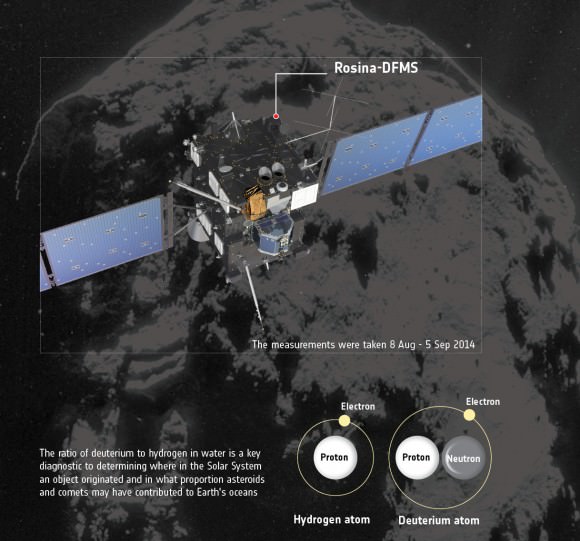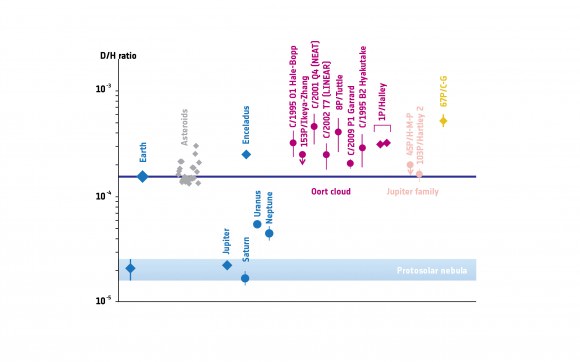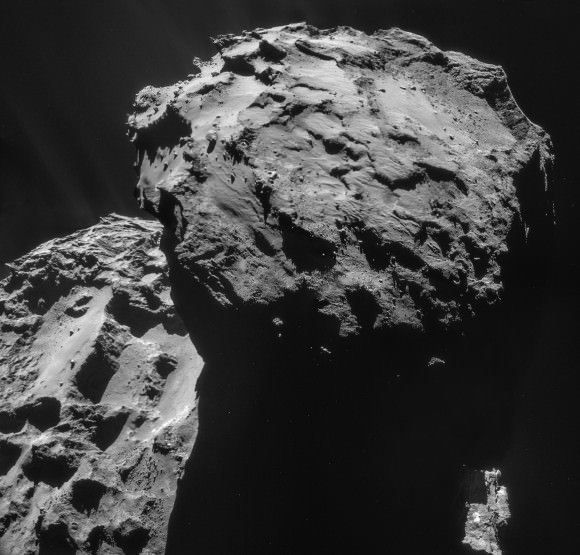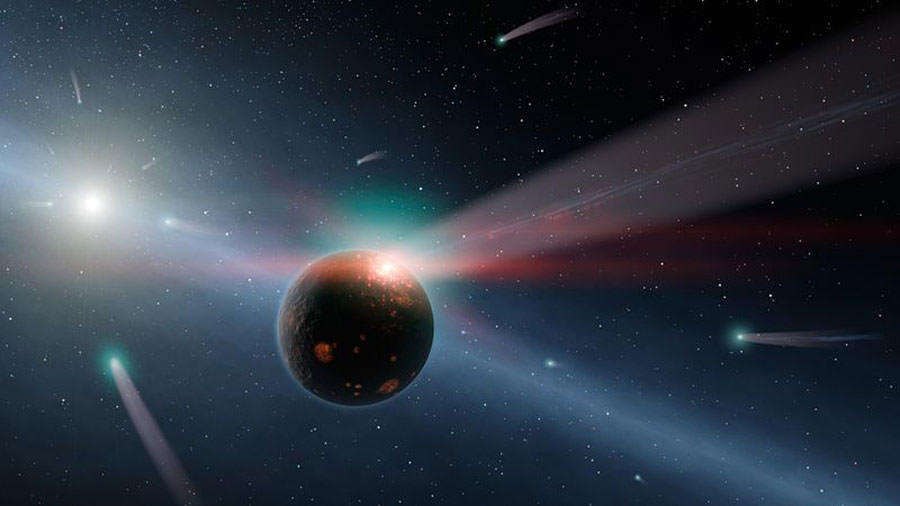Where did all of our water come from? What might seem like a simple question has challenged and intrigued planetary scientists for decades. So results just released by Rosetta mission scientists have been much anticipated and the observations of the Rosetta spacecraft instruments are telling us to look elsewhere. The water of comet 67P/Churyumov-Gerasimenko does not resemble Earth’s water.
Because the Earth was extremely hot early in its formation, scientists believe that Earth’s original water should have boiled away like that from a boiling kettle. Prevailing theories have considered two sources for a later delivery of water to the surface of the Earth once conditions had cooled. One is comets and the other is asteroids. Surely some water arrived from both sources, but the question has been which one is the predominant source.
There are two areas of our Solar System in which comets formed about 4.6 billion years ago. One is the Oort cloud far beyond Pluto. Everything points to Comet 67P’s origins being the other birthplace of comets – the Kuiper Belt in the region of Neptune and Pluto. The Rosetta results are ruling out Kuiper Belt comets as a source of Earth’s water. Previous observations of Oort cloud comets, such as Hyakutake and Hale-Bopp, have shown that they also do not have Earth-like water. So planetary scientists must reconsider their models with weight being given to the other possible source – asteroids.
The question of the source of Earth’s water has been tackled by Earth-based instruments and several probes which rendezvous with comets. In 1986, the first flyby of a comet – Comet 1P/Halley, an Oort cloud comet – revealed that its water was not like the water on Earth. How the water from these comets –Halley’s and now 67P – differs from Earth’s is in the ratio of the two types of hydrogen atoms that make up the water molecule.

Measurements by spectrometers revealed how much Deuterium – a heavier form of the Hydrogen atom – existed in relation to the most common type of Hydrogen in these comets. This ratio, designated as D/H, is about 1 in 6000 in Earth’s ocean water. For the vast majority of comets, remote or in-situ measurements have found a ratio that is higher which does not support the assertion that comets delivered water to the early Earth surface, at least not much of it.
Most recently, Hershel space telescope observations of comet Hartley 2 (103P/Hartley) caused a stir in the debate of the source of Earth’s water. The spectral measurements of the comet’s light revealed a D/H ratio just like Earth’s water. But now the Hershel observation has become more of an exception because of Rosetta’s latest measurements.

The new measurements of 67P were made by the ROSINA Double Focusing Mass Spectrometer (DFMS) on board Rosetta. Unlike remote observations using light which are less accurate, Rosetta was able to accurately measure the quantities of Deuterium and common Hydrogen surrounding the comet. Scientists could then simply determine a ratio. The results are reported in the paper “67P/Churyumov-Gerasimenko, a Jupiter Family Comet with a high D/H ratio” by K. Altwegg, et al., published in the 10 December 2014 issue of Science.

The ROSINA instrument observations determined a ratio of 5.3 ± 0.7 × 10-4, which is approximately 3 times the ratio of D/H for Earth’s water. These results do not exclude comets as a source of terrestrial water but they do redirect scientists to consider asteroids as the predominant source. While asteroids have much lower water content compared with comets, asteroids, and their smaller versions, meteoroids, are more numerous than comets. Every meteor/falling star that we see burning up in our atmosphere delivers a myriad of compounds, including water, to Earth. Early on, the onslaught of meteoroids and asteroids impacting Earth was far greater. Consequently, the small quantities of water added delivered by each could add up to what now lies in the oceans, lakes, streams, and even our bodies.
References:
D/H Ratio of Water on Earth Measured with DFMS
67P/Churyumov-Gerasimenko, a Jupiter family comet with a high D/H ratio
Rosetta fuels the debate on the Origin of Earth’s Water
Recent Universe Today related article:


“…scientists believe that Earth’s original water should have boiled away like that from a boiling kettle.”
I propose that a number of astronomers think this. Most geologists (and I think on balance most scientists) think the initial water content of the primeval Earth’s constituents is the source of most of Earth’s water and that comets just added some icing to the cake.
Much of the water “boiled away” would have frozen at high altitudes and then fallen back as rain/snow.
Venus and Mars would have been bombarded by a lot of comets too. The reason we have water and they don’t can’t just be about primeval “boiling”, since all three planets would have gone through much the same process (each starting with much the same primeval constituents). The reasons why we hung onto water are partly about Goldilocks zone, magnetosphere and atmosphere.
Yup, looks like it was in the rocks all alomg
Stop… Wait…
“In 1986, the first flyby of a comet – Comet 1P/Halley, an Oort cloud comet – revealed that its water was not like the water on Earth.”
Ok, that’s ONE… now we landed on a SECOND…. and how many are out there?
An Alien looks at the African savanna and spots some nearby elephants. In the distant he spots a herd of zebras, but they are too far away to make out details and so he concluded: “ALL animals here must have trunks!”
Before we have a “solid base” of data…. we are just assuming!! The problem is: the press / the public buys it as a FACT.
Well said TedH, Just like the way the public bought the BIG BANG theory………..
Yeah, it’s a weird one (especially the INFLATION part), but the only one today that fits the data. So for the moment we have to deal with it…. until someone comes up with a better solution.
I would favor it Douglas Adams style 😉
And what if deuterium is consumed over time ? Like it has been in the sun , but by other kind of reactions.
By the way I find it strange ,to say the least, that in the same solar system, born of the same mother ,i.e protosolar nebula, there such enormous variation in the ratio of deuterium and ordinary hydrogen. Or did the nascent solar system worked like a giant mass spectrometer ? Did I heard someone whisper “electricity ” ?
Most of the readers “forget” a very important thing: TIME ! The sun is app 5 billion years old and, especially while she was young, radiating like mad. What atomic / molecular changes have taken place in these 5 billion years? So after a while, one Thursday afternoon about tea time, one atom looses a Neutron… who cares 😉 . But millennia later this can lead to some confusion.
I’m still leaning toward Mr. Sol as the source of our solar systems water. Perhaps the composition of the solar wind is variable? There may have been periods where ionized oxygen was the dominant species therein? Captured with ionized hydrogen in our complex magnetic field(s).. they are spun up and combine to form H2O ices. If this is true? Then there were Ice Ages on Mars at the same time there where Ice Ages on Earth. If that could be proven.. then…
Did Noah see intense yellow/green Aurora’s?